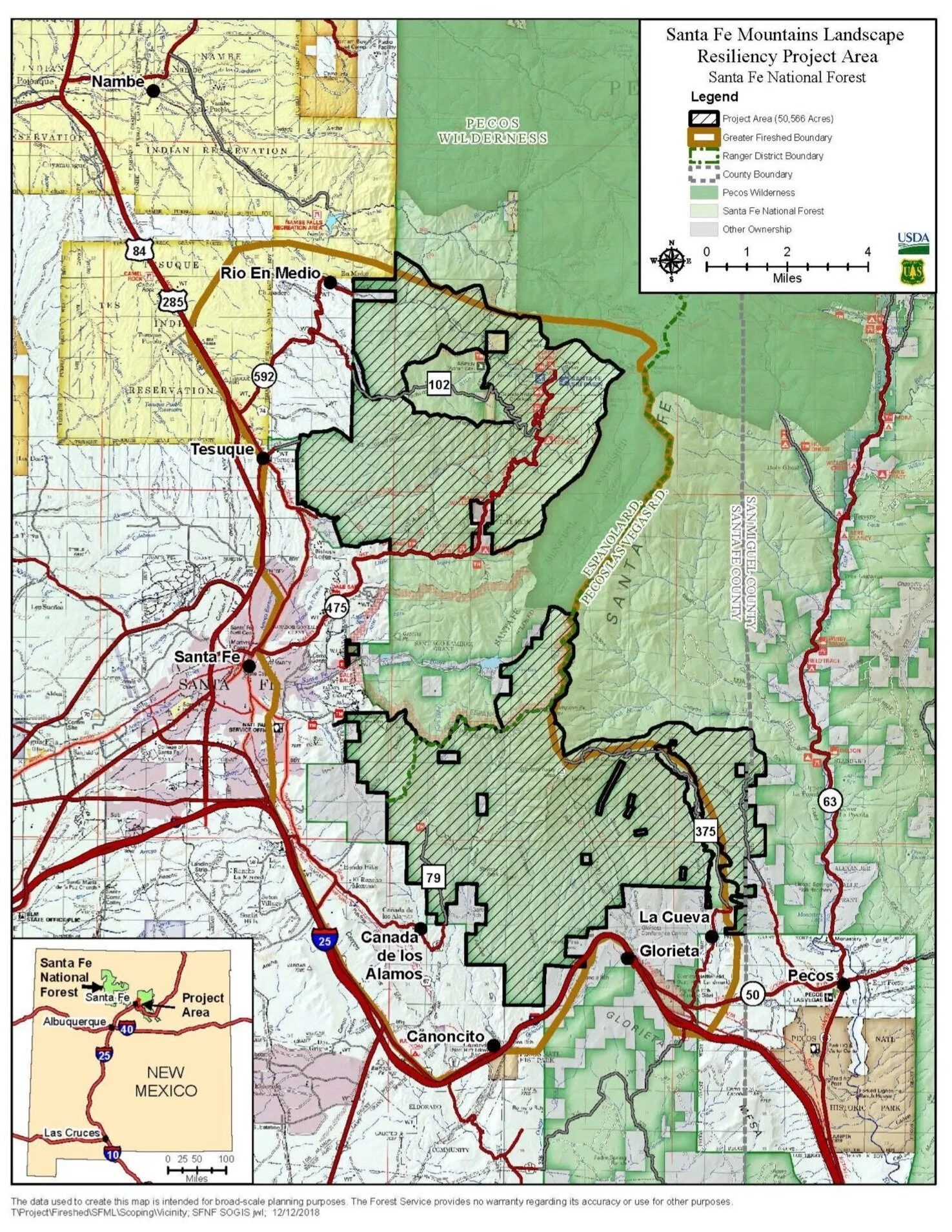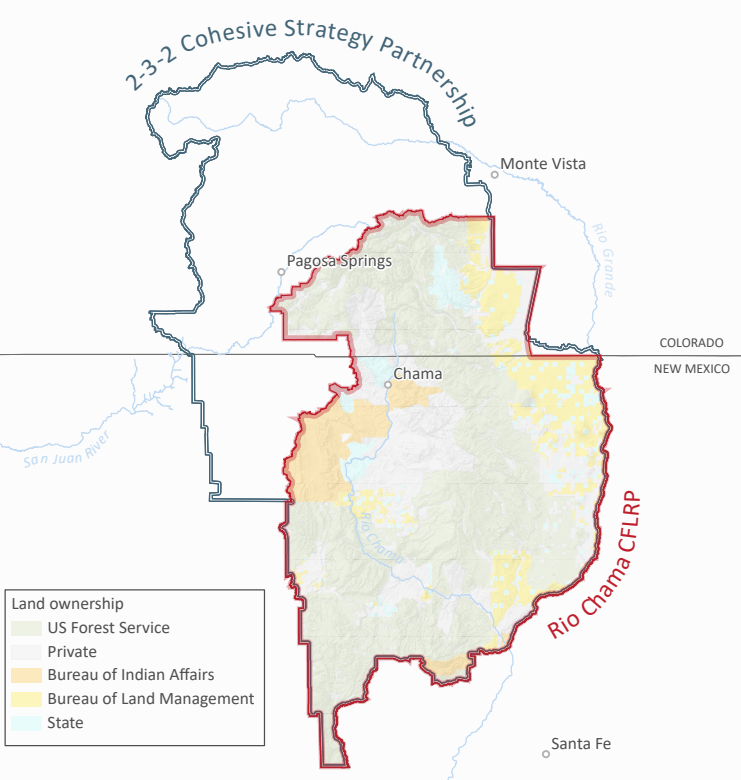Hi Fireshed community,
The mix of fire effects that we see on the landscape contribute to it’s overall resilience - the ability of the forest to “bounce back,” or sustain ecological functions, despite a disturbance. For example, when we see large areas that burn at high severity (high mortality of trees), natural regeneration of the forest becomes challenging, we have to consider more expensive replanting efforts, and we may lose the forested headwaters that provide water to our arid landscape.
To support landscape resilience. land managers use forestry treatments like thinning and prescribed fire to create a diversity of forest structures on the landscape. This diversity of forest structures contributes to a mixed pattern of fire effects when we do see wildfire. Through this variation in forest structures across the landscape, we begin to see a “mosaic” of treated and un-treated areas that can help protect our forests from widespread mortality when we have natural or human-ignited wildfires.
There are many landscape resilience projects happening across the state. This Wildfire Wednesday will feature some (but not all) of the important landscape-scale projects that are helping to protect the future of our forests and watersheds, including:
The Santa Fe Mountains Landscape Resiliency Project
The Rio Chama Collaborative Forest Landscape Restoration Project (CFLRP)
Best,
Gabe
Landscape Resilience Projects
What are they?
A map from the 2020 NM Forest Action Plan showing 250 of the highest priority watersheds for landscape resilience projects. These watersheds are at the HUC 12 scale (~10,000 - 40,000 acres).
Landscape Scale Restoration projects cross multiple jurisdictions, including Tribal, state and local government, and private forest land, to address large-scale issues such as wildfire risk reduction, watershed protection and restoration, and the spread of invasive species, insect infestation and disease. Projects are developed in partnership with diverse stakeholders and effectively leverage local knowledge, expertise, and resources which results in measurable on-the-ground impacts.
"Landscape scale" does not merely mean acting at a bigger scale: it means conservation is carried out at the correct scale and that it takes into account the human elements of the landscape, both past and present. For many of the projects in New Mexico, our definitions of landscape-scale are closely linked to water - often using watersheds of various sizes or larger river drainage basins.
The Santa Fe Mountains Landscape Resilience Project
Project Status
Signing of the SFMLRP environmental assessment - May 18th, 2023
Surrounded by State, Tribal, and Local partners Thursday, Santa Fe National Forest (SFNF) Supervisor Shaun Sanchez and Acting Deputy Forest Supervisor Jeremy Marshall finalized and signed the Santa Fe Mountains Landscape Resiliency Project (SFMLRP) environmental assessment on Thursday, May 18th, 2023.
Context
The SFMLRP is a 10-year restoration project with actions focused on helping the ponderosa pine and frequent-fire mixed conifer landscapes near New Mexico’s capital city increase resiliency to threats like high-severity wildfire, insects and disease infestation, and climate change. The SFMLRP spans approximately 50,000 acre area, although not all of the area within the project boundary will receive treatment.
Goals
A map of the Santa Fe Mountains Landscape Resiliency Project (SFMLRP)
The purpose of the Santa Fe Mountains Landscape Resiliency Project is to increase the resilience of a priority landscape to future disturbances such as high-severity wildfire, drought, and insect and disease outbreaks. Resilience is the “ability of a social or ecological system to absorb disturbance while retaining the same basic structure and ways of functioning, the capacity for self-organization, and the capacity to adapt to stress and change” (Forest Service Manual 2020.5). This purpose would primarily be accomplished by restoring characteristic structure, function, composition, and spatial pattern to the ponderosa pine and dry mixed conifer forests that comprise much of this landscape. A critical component of improving resilience in the Project Area is creating conditions that facilitate the safe reintroduction of fire, a keystone ecological process, across this landscape.
To increase the resilience of the forests, watersheds, and communities of the Santa Fe Fireshed, The SFMLRP will:
Move forests and woodlands (including ponderosa pine, dry mixed conifer, aspen, and piñon-juniper) in the Project Area towards their characteristic species composition, structure and spatial patterns in order to improve ecological function;
reduce the risk for high-severity wildfire, create safe, defensible zones for firefighters in areas of continuous fuels and near valued resources that are at risk, and avoid negative post-fire impacts;
improve the diversity and quality of habitat for wildlife; and
improve soil and watershed conditions.
To stay informed about the status of this project, you can visit the Project website.
The Rio Chama Collaborative Forest Landscape Restoration Project (CFLRP)
Project Status
A map of the Rio Chama CFLRP landscape
Throughout the summer and fall of 2022, forests and meeting spaces throughout northern New Mexico and southern Colorado were filled with discussion surrounding the Rio Chama Collaborative Forest Landscape Restoration Program (CFLRP). Funding for the Rio Chama CFLRP was announced in April of 2022 and the project is underway.
Context
The Collaborative Forest Landscape Restoration Program (CFLRP), enabled by Congress, is designed to increase the resiliency of forests and watersheds in priority forests across the U.S.
The Rio Chama CFLRP provides $30 million in funding over ten years. While the funds from the Forest Service are reserved for federal land, the project is intended to address all lands; private, state, and federal. The federal dollars are leveraged to secure funding for cross-boundary work which is facilitated by a local collaborative group, called the 2-3-2 partnership.
The project covers 3.77 million acres across the region and will provide funding over a 10-year period. The project aims to reduce the risk of uncharacteristic wildfire, restore natural fire patterns, improve watershed resilience and health, and enhance the economic sustainability of industries in the region.
Goals
A bend in the Rio Chama river in the Fall.
The project aims to reduce uncharacteristic wildfire risk by decreasing tree densities and restoring fire regimes to fire-adapted landscapes where low-intensity and mixed-severity fire were prevalent prior fire suppression policy. The suppression and absence of fire in forests of the American Southwest since approximately the 1880s has allowed our forests to become unnaturally dense, which often leads to uncharacteristically intense fire. This wildfire risk has become amplified by climate change. The CFLRP investment is focused on this landscape due to its high priority for water, wildlife, streams and community values.
Increase the forest resilience to disturbances like wildfire, insects, disease, and climate change
Restore watershed and riparian areas to improve water quality and watershed function
Improve range conditions and wildlife habitat and connectivity
Support local rural economies and create jobs by utilizing restoration byproducts
Connect with tribal, land grant and acequia communities, and engaging youth in public land management





